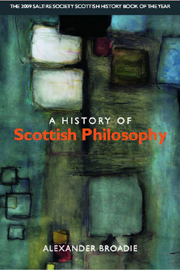Book contents
- Frontmatter
- Contents
- Acknowledgements
- 1 Introduction
- 2 John Duns Scotus
- 3 The Fifteenth Century
- 4 The Circle of John Mair
- 5 Humanism and After
- 6 Scotland Moves into the Age of Enlightenment
- 7 David Hume
- 8 Adam Smith
- 9 The Scottish School of Common Sense Philosophy
- 10 The Nineteenth Century: Ferrier to Seth
- 11 Realism and Idealism: Some Twentieth-century Narratives
- 12 Conclusion
- Bibliography
- Index
8 - Adam Smith
Published online by Cambridge University Press: 12 September 2012
- Frontmatter
- Contents
- Acknowledgements
- 1 Introduction
- 2 John Duns Scotus
- 3 The Fifteenth Century
- 4 The Circle of John Mair
- 5 Humanism and After
- 6 Scotland Moves into the Age of Enlightenment
- 7 David Hume
- 8 Adam Smith
- 9 The Scottish School of Common Sense Philosophy
- 10 The Nineteenth Century: Ferrier to Seth
- 11 Realism and Idealism: Some Twentieth-century Narratives
- 12 Conclusion
- Bibliography
- Index
Summary
Section 1: A portrait of Adam Smith
Smith was born in Kirkcaldy, Fife, in 1723. His father, also named Adam Smith, an Edinburgh lawyer and later comptroller of customs at Kirkcaldy, died shortly before his son was born, and young Adam was brought up by his mother Margaret Douglas (d. 1784), to whom he remained devoted and with whom he lived for much the greater part of his life.
Smith learned Latin at his school in Kirkcaldy and then at the age of fourteen went up to Glasgow University, where his subjects were Latin, Greek, mathematics, science and philosophy. Thereafter he remembered with affection his Glasgow teacher, the ‘never to be forgotten Dr Hutcheson’, and also spoke very respectfully of another Glasgow professor, the mathematician Robert Simson. Writing of Simpson and of the Edinburgh mathematician Matthew Stewart (father of the philosopher Dugald Stewart), he affirmed that they were ‘the two greatest mathematicians that I ever have had the honour to be known to’ and added that they were ‘the two greatest [mathematicians] that have lived in my time’. These references are important as indicating Smith's early and lasting interest in science including the mathematical sciences. He was not a practising scientist and made no significant contribution to mathematics, physics or the other natural sciences, but he wrote with real sophistication about the philosophical dimension of the great scientific enterprise of western Europe.
- Type
- Chapter
- Information
- A History of Scottish Philosophy , pp. 196 - 234Publisher: Edinburgh University PressPrint publication year: 2008



